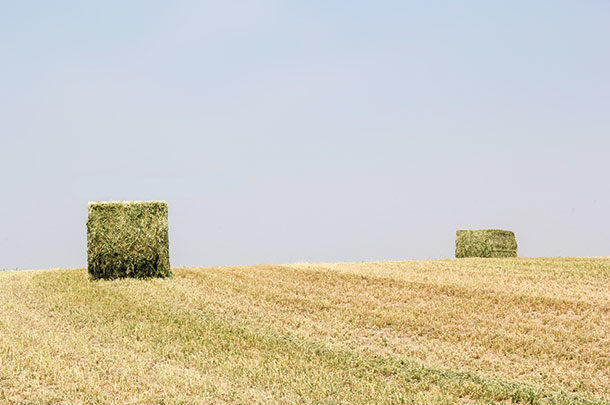When deciding to take a fall harvest of alfalfa, here are five questions to consider before you mow.
What is the forage worth?
If you already have enough forage to get you through until next spring, then the forage isn’t worth as much as if you need forage. However, with increasing herd sizes, the concurrent need for more forages has resulted in farmers putting higher value on that fall forage.
How much gas does the alfalfa have in its tank?
Alfalfa root carbohydrate reserves (gas in the tank) accumulate during each regrowth cycle until late flower, when accumulation stops. After cutting, these reserves are used (gas level drops) to support stem and leaf growth until 6 to 8 inches of regrowth is present, at which time root carbohydrates begin to accumulate again (refill the tank).
Short intervals between harvests do not allow root carbohydrate reserves to completely replenish. Repeated frequent cuts over the growing season can reduce the reserves to a dangerously low level. About 50 percent of the root carbohydrate reserves are used during the winter for plant survival.
The remaining carbohydrates are available in the spring to support initial plant growth. Winter survival and spring regrowth of the alfalfa plant is dependent upon adequate carbohydrates being stored before cold temperatures kill the herbage in the fall. Taking at least one harvest during the growing season at 50 percent bloom reduces the risk of fall harvest compared to taking all harvests at bud stage.
During the fall, fall-dormant alfalfa plants develop cold resistance in response to shortening day lengths and cool temperatures. This process, known as hardening, involves reduced herbage growth and increased carbohydrate storage in the roots. Alfalfa harvest during this enhanced carbohydrate storage period disrupts carbohydrate production and storage.
If good growing conditions occur after cutting alfalfa in the fall, then the plants will begin to regrow and expend stored carbohydrates in the process. Unfortunately, this regrowth is generally insufficient to restore all the root carbohydrates before the first killing frost, which increases the risk of weak plants the following spring or outright death during winter.
Discovery of this root carbohydrate flux led to the traditional recommendation not to harvest alfalfa four to six weeks before the first killing frost. However, advances in alfalfa breeding and overall alfalfa management allow greater flexibility in fall harvest management than traditionally recommended.
Fall harvesting can stress the alfalfa plant and increase the risk for winter injury, but management practices and planning can minimize this risk.
Is the soil fertility optimum?
Maintaining soil fertility levels is extremely important in reducing risks associated with fall harvesting. Low potassium levels in the soil have been directly correlated to poor winter survival of alfalfa.
How old is the alfalfa stand?
Young stands are less susceptible to winter injury due to fall harvesting than older stands. As stands age, they become infected with various diseases, and their crowns become damaged from wheel traffic. This weakens them and makes them more susceptible to winter damage.
Is the soil well-drained?
Wet soils suppress alfalfa regrowth and slow the accumulation of root carbohydrates. In addition, wet soils tend to have greater frost heaving than dryer soils. Fall alfalfa growth left in the field over winter reduces the risk of frost heaving.
Risks associated with fall harvest can be minimized through management, use of alfalfa varieties with sufficient levels of disease resistance and winter hardiness, and adequate levels of soil fertility (especially potassium).
Legal disclaimer
Following all these precautions doesn’t guarantee your alfalfa will not suffer from winter injury. In fact, nothing you can do will guarantee your alfalfa will survive the winter. Sometimes Mother Nature trumps all our efforts.
However, if it is a close call between plant survival and death, then following the above precautions may be the difference between having a nice alfalfa stand next spring or having to rotate that field out of alfalfa. FG
PHOTO: Big bales out in the field during fall harvest. Photo courtesy of Mike Dixon.

-
Marvin Hall
- Forage Specialist
- Penn State University
- Email Marvin Hall












